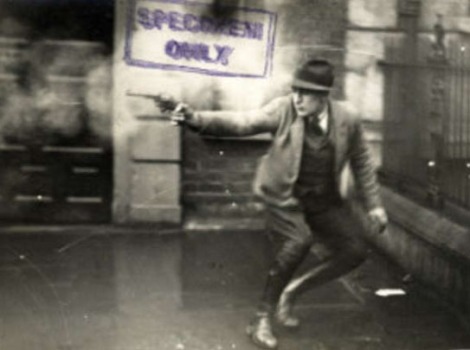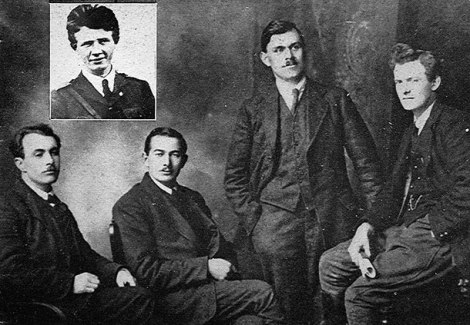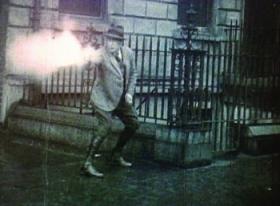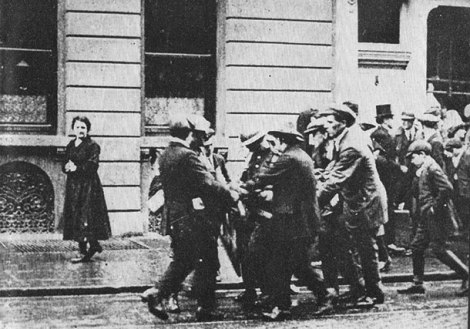
Lieutenant Gilbert Arthur Price, a British intelligence officer, fires his gun moment before he himself is gunned down, probably by Sean Treacy’s parabellum as granddad looked on. This photograph is likely to have been set up and taken some years after the event. https://www.historyireland.com/20th-century-contemporary-history/the-true-story-of-a-remarkable-photograph/
We are going to skip forward six months now to a time when granddad was back in Dublin. The reason for this is that one of my uncles, Father Michael, a Salesian brother who spent much of his career in Brazil, on hearing of my blog and particularly of the post mentioning the Cairo Gang, has sent on a newspaper clipping from the letter page of the Irish Independent, dated February 6th 1967. In this letter, my granddad had written of how he had witnessed the shooting of Sean Treacy on Talbot Street in Dublin in October of 1920, only four months after he had returned from South Russia. While Russia was in the throes of a most barbaric era, Ireland was having troubles of its own and Sean Treacy was a main mover in starting the Irish war of Independence in 1919. As the last post mentioned guns quite a bit (as well as the fez which we will return to), I thought this incident is interesting for context. It must have seemed war was everywhere to the people at the time and it may also explain my granddad’s lifelong familiarity with guns, a familiarity that was obviously common.

Séamus Robinson, Seán Treacy, Dan Breen, Michael Brennan and Seán Hogan (inset)(MacThomais, 2015).
Some historians consider that Seán Treacy may have been the most feared IRA operative in Ireland. A hardened killer with the sensibilities and manners of a monk, Treacy was one of the few IRA soldiers to stand up to Michael Collins. Treacy came from a small-farming background in County Tipperary. He was a member of the Gaelic League, the Irish Republican Brotherhood (IRB) and then the Irish Volunteers. He was arrested in the aftermath of the Easter Rising in 1916 and spent much of the following two years in prison, where he went on hunger strike on several occasions. In 1918 he was appointed Vice Officer-Commanding of the Third Tipperary Brigade of the Volunteers (which became the Irish Republican Army in 1919). On 21 January 1919 Treacy and Dan Breen, together with Seán Hogan, Séamus Robinson and five other volunteers, helped to ignite the conflict that was to become the Irish War of Independence. They ambushed and shot dead two members of the Royal Irish Constabulary (RIC) — Constables Patrick MacDonnell and James O’Connell — near their homes at Soloheadbeg in County Tipperary.
Breen later recalled:
“…Treacy had stated to me that the only way of starting a war was to kill someone, and we wanted to start a war…”
As a result of the action, South Tipperary was placed under martial law. When Seán Hogan, was arrested on 12 May 1919, Treacy, Breen and Séamus Robinson amongst others went to Hogan’s rescue as he was being transported by train to Cork city on 13 May 1919. The men, led by Treacy, boarded the train in Knocklong and a vicious close-range struggle, involving man-to-man combat, ensued. Treacy and Breen were seriously wounded in the gunfight. Two policemen died, but Hogan was rescued. Treacy had to leave Tipperary for Dublin in order to avoid capture. In Dublin, Michael Collins employed Treacy on assassination operations with “the Squad”. By the spring of 1920 the Royal Irish Constabulary and the Special Branch had been effectively neutralized by IRA counterintelligence operatives working for Collins. At this point the British thoroughly reorganized their administration at Dublin Castle, appointing Army Colonel Ormande de l’Eppe Winter as Chief of a new Combined Intelligence Service (CIS) for Ireland.
Treacy returned to Tipperary in the summer of 1920 to organise some attacks and afterwards once again took refuge in Dublin. British intelligence spotted Treacy and Breen shortly after their arrival and put them under surveillance. In October 1920, Treacy and Breen were holed up in a safehouse at Drumcondra, north Dublin when it was raided by a police unit. In the ensuing shootout, two senior British officers were wounded and died the next day, Major Smyth and Captain White. The homeowner, Dr. Carolan, was killed. Treacy and Breen managed to shoot their way through the police cordon. The injured Breen was spirited away to Dublin’s Mater hospital. Treacy had been wounded but not seriously. The British search for the two was intense and Collins ordered the Squad to guard them while plans were laid for Treacy to be taken out of Dublin. Treacy hoped to return to Tipperary; realizing that the major thoroughfares would be under surveillance, he purchased a bicycle with the intent of cycling to Tipperary via the back roads.
It was not to be. Treacy, on arriving late at a safe house on October 14th to meet with Michael Collins and others found they had dispersed. The British who had been shadowing him in the hope of capturing others decided to stake out the house and a decision was made to apprehend Treacy as soon as he emerged. When Treacy eventually stepped out, Price drew his pistol and closed in on Treacy who drew his parabellum automatic pistol and shot Price and another British agent before he was hit in the head, dying instantly. This account is in Joe Ambrose’s 2007 book, Sean Treacy and the Tan War and also recounts that Treacy, reaching for his bike, grabbed the wrong one, a bigger one, and fell to the ground.
My granddad’s account describe it a bit differently.
Prior to the shooting I was walking down North Earl Street towards Talbot Street when a lorry containing British troops passed by traveling slowly. I walked on into Talbot street with the lorry only a short distance ahead of me. As the lorry reached the Republican Outfitters shop I saw Sean Treacy – of course I did not know who he was then – running up the street in my direction with a gun in his hand. At this time the lorry was practically (if not actually ) stopped and a man in mufti jumped out of it and pursued Treacy who fired a shot or two in the direction of the lorry. Both men came to grips, just as Colonel Neligan describes it, outside a pork butcher’s shop and were struggling when shots were fired from the lorry, killing them both. Some of the bullets from the lorry went through the pork shop window and others went into the foyer of the adjoining Masterpiece Cinema. Obviously, as Colonel Neligan had said, the soldiers in the lorry had panicked.

Another shot of Price supposedly taken by 15-year-old apprentice photographer John Hogan just seconds before Price is himself shot. However as with the previous photo it is likely to have been a set up some years after the event though possibly taken by Hogan.
Another account by Shane MacThomáis – a Dublin historian described as a mine of information and who died at the age of 46 in 2014 – published (posthumously) in the Republican paper An Phoblacht sounds more realistic. It describes an even more confused scene as well as providing photos of the panic. This article also mentions something granddad typically makes light of – the shooting by the British into the crowds of civilians on the street.
At 4.15pm, the meeting concluded and the four men were standing close to the entrance of the shop when they heard the approach of two lorries full of armed soldiers. Dick McKee was closest to the door and, after looking out, he shouted: “They’re coming – get out!”
Seán rushed out of the shop and grabbed a bicycle that was not his own and was too big for him. He overbalanced and was immediately fired on by two of the plainclothes detectives that had accompanied the soldiers. Seán returned fire and drove them off; one of them, Francis Christian, a Castle spy, collapsed and died. Two more assailants fired at Seán from close range. As Treacy turned to tackle one he was shot through the head at five yards’ range and fell dead. One of his opponents, Price, was killed outright and lay dead at Seán Treacy’s feet.
Seeing some of their agents fall caused panic among the British soldiers and they began firing indiscriminately on the crowds of civilians caught in the street. Two innocent bystanders were killed by the soldiers: a 15-year-old messenger boy called Patrick Carroll and Joseph Corringham, who was hit in the stomach by a bullet as he cycled up the street.
Extrapolating from this account my granddad walked onto Talbot Street after Treacy’s struggle with the wrong bike and the collapse of Christian but in time to see Treacy running up the street pursued by Price, seeing them come to grips and both fall at the same time, Treacy felled by a shot from the lorry while Price was killed perhaps by Treacy’s parabellum or maybe by friendly fire.

Francis Christian, a Castle spy, is carried down Talbot Street to the British Army lorries after he had collapsed and he died shortly after. (MacThomáis, 2015)
Treacy’s death sent alarm bells through the IRA leadership and appears to have been a factor in the decision to approve Michael Collins’ (Director of Intelligence) plan to assassinate en masse some two dozen British Secret Service agents, Special Branch agents and British informers a month later. These assassinations were carried out on Sunday, November 21, 1920—a date that has been called “Bloody Sunday”
Dan Breen went on to write a book, My Fight for Irish Freedom – which also mentions Treacy dying outside a pork butchers (Breen, p.64). Breen died in 1969 (McGreevy, 2015). The violence would escalate even more from the time of Treacy’s death until the Truce in July 1921.

The dead are taken away. (MacThomáis, 2015)
Granddad’s records state that he was discharged from the ordnance depot at Islandbridge (now called Clancy Barracks) in Dublin on change of government which would have been early in 1922 when the treaty which created the Irish republic came into being. I imagine he was employed by the British Army and in the same capacity as in South Russia, which was in logistics. It is likely then that Islandbridge is where he was coming from when he came across the scene in Talbot Street in October 1920. Islandbridge is beside the Liffey near Heuston Station and the Irish Museum of Modern Art. Talbot Street is perhaps a forty minute walk away (we are a long-legged family) while fifteen minutes further is the house in East Wall where granddad had grown up and most likely where he was currently living with his mother Annie who would live there until her death in 1939. This means he got off work at 3:30pm or earlier. Nice for him.

Granddad’s route home from Islandbridge.
After the war of Independence and the truce of July 1921 and overlapping the introduction of the treaty of 1922 came the Irish Civil War. The anti-treaty faction – who wanted to restart war with the British in order to retain the full 32 counties – fought the pro-treaty side. In the summer of 1922, granddad would join the Irish Army (pro-treaty) as a member of the 3rd Battalion of Dublin Guards – according to his records he was a member of the military police – landing in Fenit in Kerry in August 1922, the same month pro-treaty leader Michael Collins was ambushed and killed in Beal na mBlath in the adjoining county of Cork. Granddad would remain stationed in Kerry for the duration.

William Gerald Forbes Scott (left), Kerry, 1922
In 1923 at the end of the war of Independence he joined the Gardai Siochana until he retired in 1962…

Further Reading, References & Images.
Adams Auctioneers (2018), Gun Battle in Talbot Street, [online], available at https://www.adams.ie/Gun-Battle-in-Talbot-Street-Sean-Treacy-An-original-photograph-stamped-Specimen-Only-approx-15-x-20cm-showing-the-British-intelligence-officer-Lieut-Price-taking-aim-firing-seconds-before-he-was-shot?Itemid=&view=lot_detail
Ambrose, Joe (2007), Seán Treacy and the Tan War, Dublin: Mercier Press ISBN 978-1-85635-554-4, p.152
Dublin 7 Peoples History (2013), October 1920, [online], available at https://dublin7peopleshistory.wordpress.com/2013/08/19/october-1920-british-murder-gang-brings-terror-to-manor-street/ [accessed 29/09/2018]
Harvey, Dan, ( 2016), Soldiers of the Short Grass: A History of the Curragh Camp, Dublin, Merrion Press.
MacThomáis, Shane (2015), Born this day – Seán Treacy killed in Dublin City Centre shoot-out with British agents, in An Phoblacht, February 14th, [online], available at http://www.anphoblacht.com/contents/24770 [accessed 29/09/2018]
McGreevy, Ronan, (2015), Dan Breen’s Battle with Bureauocracy, in The irish Tines, December 11th, [online], available at https://www.irishtimes.com/culture/heritage/stories-of-the-revolution-dan-breen-s-battle-with-bureaucracy-1.2462077 %5Baccessed 29/09/2018]


Fascinating and amazing, also grandad is very handsome in his uniform. What a time to live in and through.
LikeLiked by 1 person
Isn’t he?….It was like the Wild West all over….I think it must’ve been difficult for many, men who had seen action especially, to go back to living in times of peace.
LikeLiked by 1 person
Thankfully he wasn’t caught in the crossfire!
LikeLiked by 1 person
I’ve missed this blog. Although the circumstances are appalling, it’s nice to hear from Granddad again.
LikeLiked by 1 person
That’s good to hear April…thanks…I’ve missed it too…while my MA is stimulating my brain, this research is closer to home and richer for it….I will try to keep it going now…I think its good for my head.
LikeLiked by 1 person
I keep coming across little snippets of information about the Russian Revolution and asking was that when and where he was. Daft really, since he wasn’t there for long. It does bring the whole thing a lot closer.
LikeLiked by 1 person
Thats great!…yeh I think having a figure you ‘know’ in the middle of something can provide a bit of an anchor and some context…which is sorely needed when descending into the chaotic history of the Russian Revolution..
LikeLiked by 1 person
Pingback: Ending & Beginning… | From Buckinghamshire to South Russia & Return Journey·
Pingback: From one war to another : Dublin 1920 – 1922 | From Dublin to South Russia & Return Journey·
Pingback: Descent into Chaos | From Dublin to South Russia & Return Journey·
Good article, I wonder if you are aware of the serious war crimes carried out by the Free State Army in Kerry during the civil war. Many Irish people will be very shocked when the details are remembered on the 100th anniversary. There will have to be some naming and shaming of the officers involved in the 3 separate cases where a total of about 20 prisoners were tied together and then blown up.
LikeLiked by 1 person
Yes I have read quite a bit about them, or as much as has been written. The Ballyseedy massacre is particularly infamous. The Dublin Guard as the outsiders seem to have been doing the dirty work and Neligan along with Daly seem to have been in the thick of it. I may even have written about it elsewhere. Still researching though. Horrible times that are still reverberating. Thanks for reading and commenting.
LikeLike
PS I would be interested in your sources regarding officers involved that haven’t already been connected to these incidents if you have any links?
LikeLike